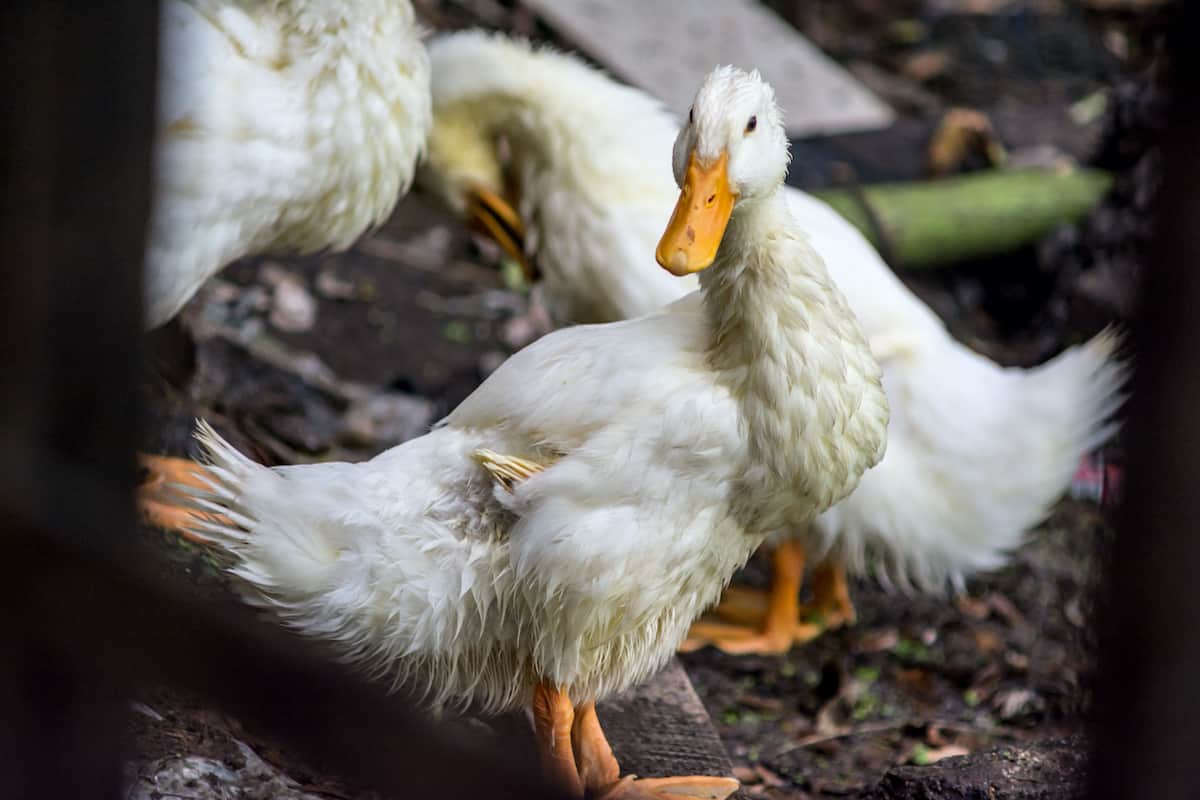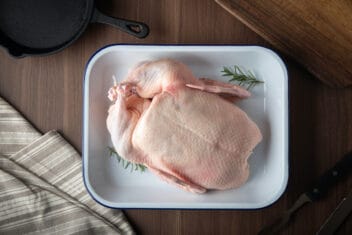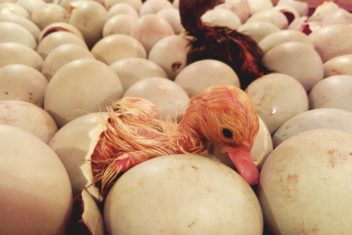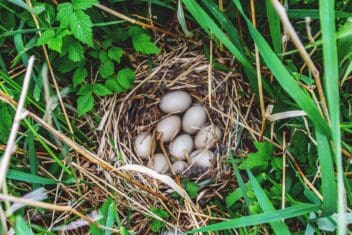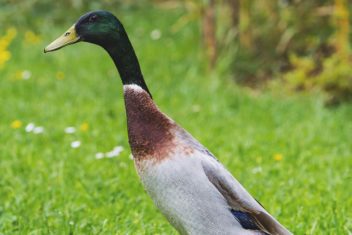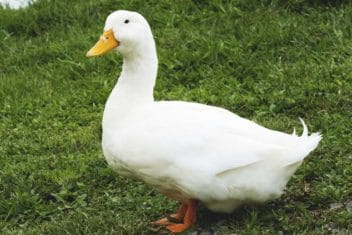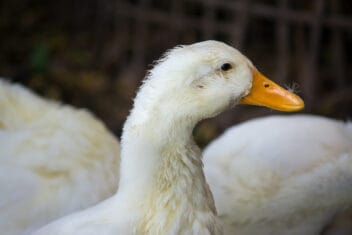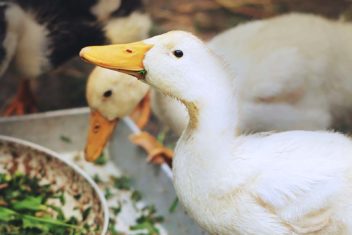I used to think that raising ducks for meat was expensive. Turns out, that was just because I was trying to raise ducks like broiler chickens.
Broilers, usually Cornish crosses, are confined, fed bagged feed, and ready to process in 45-60 days. They are extremely economical to raise because hatched chicks can be as cheap as $1 per bird. Additionally, they’ve been bred to be stationery and love eating. So, confining and fattening them is easy.
Ducks, on the other hand, are not like broilers at all. For starters, they cost $4-8 per duckling if you don’t hatch your own. Plus, even when you raise Pekins – the Cornish cross equivalent in ducks – they still love to forage, explore, and do things besides eating all day. So, they require a different approach.
The Benefits of Raising Ducks for Meat
When you try to raise ducks using industrial broiler methods you end up with loud, dirty ducks, with pent up energy that makes them pre-disposed to fear and trampling behavior. As such, it just doesn’t seem right to me to raise ducks like broiler chickens.
If you instead raise ducks – well, like ducks – they can absolutely provide you with an economical, sustainable, and more self-sufficient meat supply. You just need to approach raising ducks for meat in a more homestead-like fashion.
Here’s how to do it economically.
Breed Your Own Ducks to Keep Down Costs
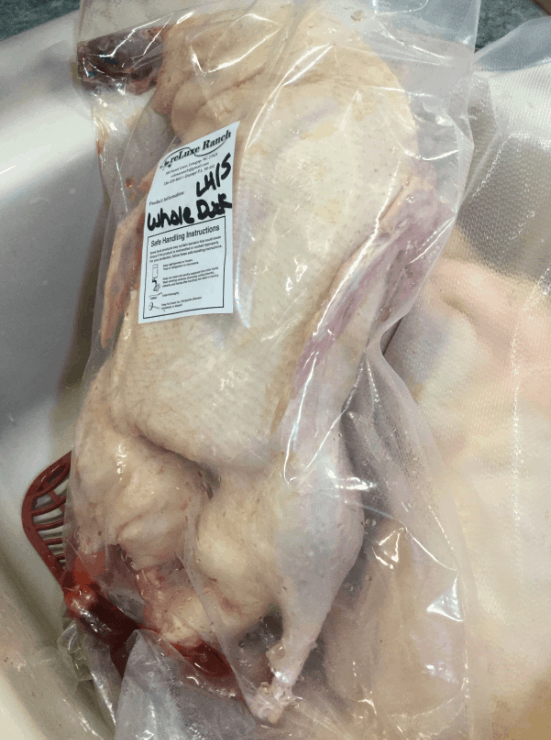
Buying ducklings is outrageously expensive and with good reason. Ducklings take longer to hatch than chickens, have lower hatch rates in incubators, and are more difficult to ship. As a result, the price point for ducklings is significantly higher than for chicks.
If you want to raise ducks for meat economically, you really need to keep your own breeding ducks. Since those same ducks can also provide your eggs, soil fertility, pest control, and endless entertainment doing that is no hardship at all. However, there are some things to consider before you get started.
1. Drake Costs
You will have to keep a drake to fertilize the eggs. That means there will be some additional year-round feed costs. However, if you are already doing things to keep your layer costs down such as raising insects or fodder, giving them access to forage, sharing garden, and kitchen scraps, those costs can be minimal.
2. Nest Setters
Additionally, unless you want to buy and operate an incubator, which means added work for you and equipment and electricity costs, you need a broody female duck to set eggs. When conditions are right, broody ducks will set nests of 10-14 eggs to hatch as your meat source.
Keep in mind that not all ducks get broody. The one big challenge in getting your meat supply started is that you may have to try a few different ducks before you find one or more that will consistently sit nest after nest, year after year.
Best and Worst Broody Duck Breeds
Lots of duck breeds do have a natural tendency toward broodiness.
1. Muscovy
Personally, I have had the best luck with the mixed feather color Muscovy females. They are seasonal layers and have a strong desire to brood anytime the weather is good. If you socialize them early, they are friendly and easy to manage.
Note: The pure white Muscovy females don’t seem as broody. I suspect this is because the white Muscovy has been bred intensively for commercial meat production. That might have had an impact on their mothering instincts.
2. Other Broody Breeds
Australian spotted, Cayuga, Dutch Hookbill, and domesticated Mallard ducks are all known to be naturally broody and good mothers. Additionally, you may get lucky and find Buff Orpington, Magpie, Rouen, Saxony, or Silver Appleyard ducks to be good at setting nests and mothering too.
3. Less Broody Breeds
Pekin, Khaki Campbell, Runner, Welsh Harlequins, and Hybrid layers do occasionally set nests. Generally, though, these breeds aren’t known for being as good at hatching and mothering.
Duck Eggs to Hatch
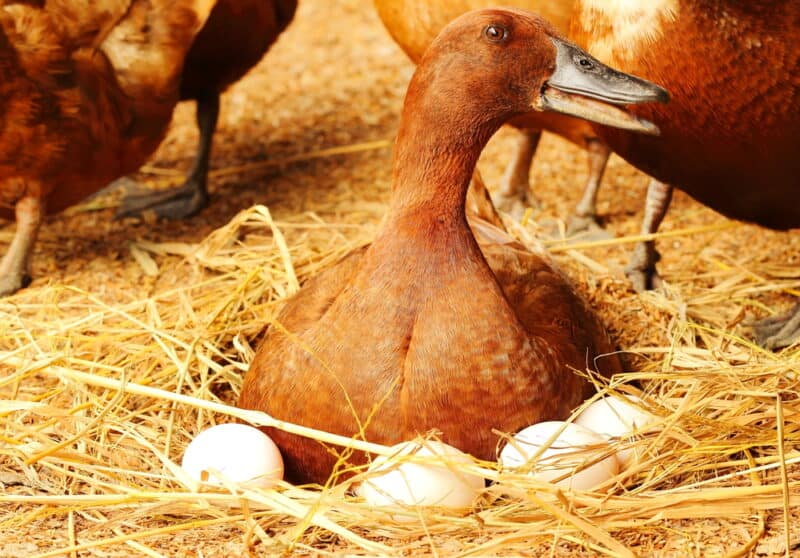
Once you have your broody mama, then you also need eggs to hatch. You can let them hatch their own eggs. However, you can also substitute eggs from other layers into the nest if you prefer to breed different types of ducks for meat.
1. Maximize Meat
For example, Muscovy ducks are great for meat. The problem is the males can get to 10-12 pounds, but the females only get to about 6 pounds. Since there’s no way to predict the sex in advance, you’ll get a mix of males and females to process.
Pekins, by contrast, tend to be roughly the same weight at processing time whether they are male or female. So, if you want to maximize your meat production, you may want to have your Muscovy duck set nests filled with eggs from your Pekin breeders.
2. Flavor Profile
For Epicurean-type homesteaders, not everything is about maximizing productivity. You may also want to fill that nest with duck eggs that will produce certain flavor profiles.
Pekin meat is mild tasting and high in fat. The meat is more pink than red. It eats a bit more like chicken than duck especially if you harvest at 8 weeks. It will develop more flavor and be steak-like if you wait to harvest until 3-4 months and let them forage a lot.
Still, if you really want flavorful meat, you may prefer to hatch out Rouen or Saxony eggs. If you prefer more breast meat to leg meat, then you might also want to focus on Silver Appleyard ducks for their large wide breast cuts.
3. Pekin Crosses
You could also cross your own breeds. For example, if you prefer to keep Khaki Campbells for eggs, then you could keep a Pekin male to breed with them. That way when your eggs hatch, they’ll be Pekin/Campbell crosses.
Those crosses will usually be larger and mature faster than a pure Khaki Campbell would. This way, you get to keep high production egg layers for your year-round egg supply. Still, by crossing them with a larger breed, the hatched ducks will be larger and faster-growing for more efficient meat supply.
Keep in mind though that breeding a small female duck to a large male duck can be tough on the ladies. In cases like that, I like to plan conjugal visits rather than allow regular cohabitation.
What about “Moulard”?
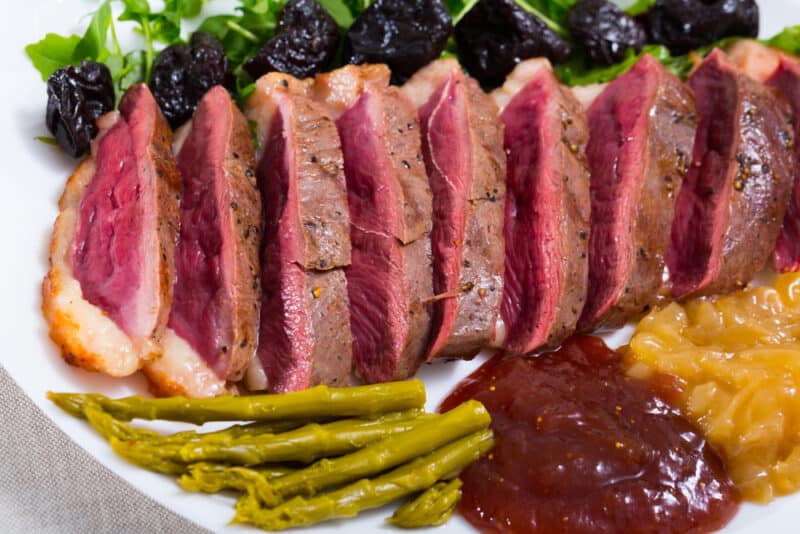
You can also cross a Muscovy male with Pekin females to get the famed “moulard” (French for mule) duck associated with foie gras. Even if you don’t want foie gras, that cross makes particularly tasty meat that is lean and flavorful with a fine layer of fat over the breast area.
Warning!! This is not for beginners. Since most duck eggs hatch in 28 days and Muscovy duck eggs hatch in 35, when you cross these ducks you get irregular hatch rates. That means you may have eggs hatching over a longer period rather than all at once.
Once most of the ducks have hatched, the broody mama will get off the nest and leave any unhatched eggs behind. You can have lots of unhatched eggs if you use a broody duck to hatch Moulard eggs.
If you do want to try to hatch some Moulard, plan to use an incubator and raise those ducklings yourself. Also, make sure to cross the male Muscovy to the female Pekin so that the offspring are larger and more consistent in development.
If you cross the other way, you’ll end up with some of your ducklings turning into beautiful light-colored females that never size up properly. They aren’t so good for meat, but they do make particularly fine pets that are sterile.
The Benefits of Mixed Breeds
If you keep several breeds of ducks, it can also be a good strategy to hatch a few fertilized eggs from each of your breeds. Since the breeds tend to size up at different rates, by doing this you can stagger your harvests based on when ducks are naturally ready to process.
1. Process at Once
For example, Pekins all size up at roughly the same rate. You may occasionally get a late bloomer, but that usually means something went wrong in incubation.
If you only hatch pure Pekin eggs, you’ll end up doing a lot of processing, packaging, and freezing over a week or two to harvest at the perfect size, flavor, and texture profile.
2. Process As Needed
If you instead keep a Pekin drake to cross with whatever egg layers you already keep, you can have ducks with different development rates sizing up and developing peak flavor at different times. Your Pekins will always be first, but then you could have later harvests of Pekin crosses extending for up to 6 months from the hatch date.
About Raising Ducklings
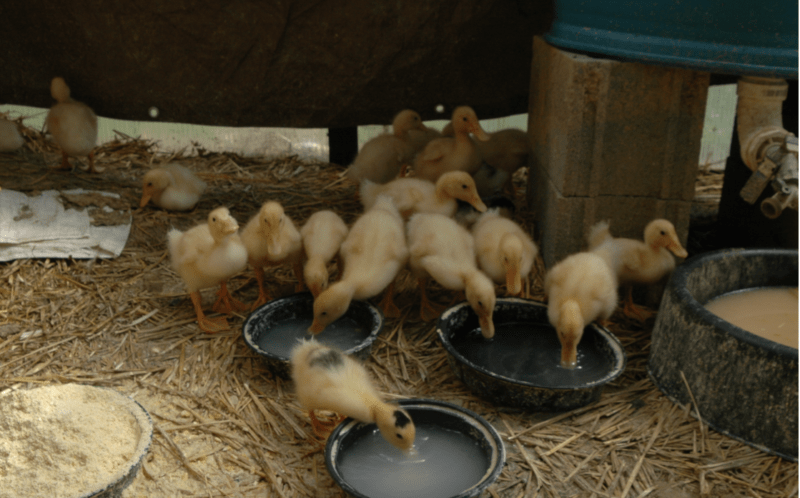
Now you know some strategies to hatch your own ducklings for meat using your laying flock, we still need to talk about raising those ducklings.
1. Multiple Hatches
If you want to guarantee your ducks set multiple nests each year, you’ll need to take away those ducklings right after hatching and raise them yourself. By doing that, your broody duck stays broody.
After a couple weeks of laying a new clutch of eggs, she’ll set again.
2. Duck Raised Ducklings
If you let her raise out the ducklings, that will save you a lot of work. It will also save you money too because she will teach them how to forage effectively early on. Yet, once she has raised ducklings, she may or may not want to set another nest again in the same mating season.
3. Best of Both Worlds?
If you have a long hot season, you have better chances of getting a broody duck to set and raise more than one round of ducklings per year. However, in areas with shorter warm periods, she may not feel that she has the time to get them to maturity before the season ends.
I live in a warm area, so I haven’t tried this. However, I have heard that in cooler climates you can make a duck broody earlier by heating your nesting area.
I don’t know if the electricity costs and fire risks are worth it. It may be easier to keep more broody ducks and let them lay in season. That’s up to you.
4. Broody Mama Care
Setting a nest is hard work. If you do want to use your broody mama more than once a season, give her the best feed you can afford and special treats to keep her in fine form.
Cost of Feeding Ducklings
How much bagged feed you need to give your meat ducks will vary by your environmental conditions.
1. Limited Forage
If you have a typical suburban backyard with a mowed lawn and a few landscape plants, your available forage will be minimal. You’ll need to feed ducklings formulated feed as the majority of their diet.
In a scenario like that, you should expect to feed your ducks about 3 pounds of feed per pound of harvest weight. For a Pekin harvested at 8 pounds, that would mean 24 pounds of feed. If your feed is $14 per bag, that’s a cost of $6.72 per duck.
There are things you can do to keep costs lower than that. For example, set slug traps using leafy greens or wood boards. Then let the ducklings eat the slugs. You can also raise fodder and insects to offset costs.
Chopped up kitchen and garden scraps can help too.
2. Lots of Forage
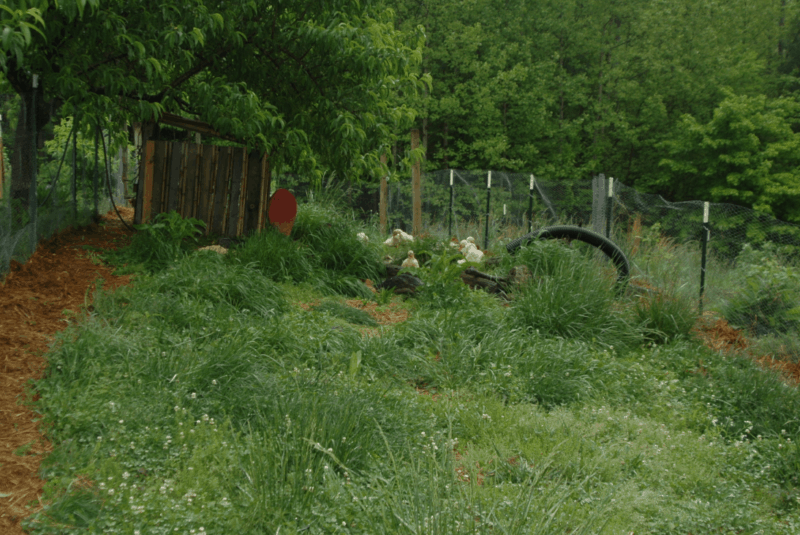
If you really want to save on feed though, you need to provide lots of appropriate forage. For example, if your homestead is densely landscaped using Permaculture methods, ducklings raised by their mama ducks will have access to lots of food options.
When I let my mama ducks raise their ducklings on good forage land, I normally only buy one 50-pound bag of feed for every 8 ducklings over their entire lifespan. Rather than going with lower protein duck feed, I use a 28% protein game bird starter.
That 28% protein is much too high for ducks in confinement. However, since my ducklings get most of their food from forage, the high protein feed is just a supplement to round out their protein needs during their fast growth spurts.
This works because I have all sorts of wild berries, plants with edible seeds, aquatic life, cover crops, and more for ducks to eat as their dietary mainstays. It took a few years for me to establish a landscape that provided lots of feed for ducks.
Now, though, I spend about $2.50 per duck with harvest weights of 6-8 pounds.
Final Thoughts
If you know how to take care of ducks, and have the room to raise a few extras, they can absolutely be an economical, sustainable meat option. The hardest part isn’t raising them, though. It’s processing them.
For people (like me) who grew up eating packaged cuts of meat from the supermarket, or pre-cooked meat at a restaurant, this can be a real challenge at the outset. Personally, I remind myself that this is how people did it for tens of thousands of years.
Being able to buy a processed carcass cut whenever you want it is a very recent innovation. Realizing that raising your own livestock for meat is more “normal” over the course of human history helps me find the courage to do it.
Also, loving ducks like I do, there is no way I can imagine eating one raised in a factory farm environment. I will tell you though, I eat a lot less meat as a homesteader than I did as a shopper. So, be warned, raising animals for meat, be it ducks or other livestock, will likely change your perspective too.
